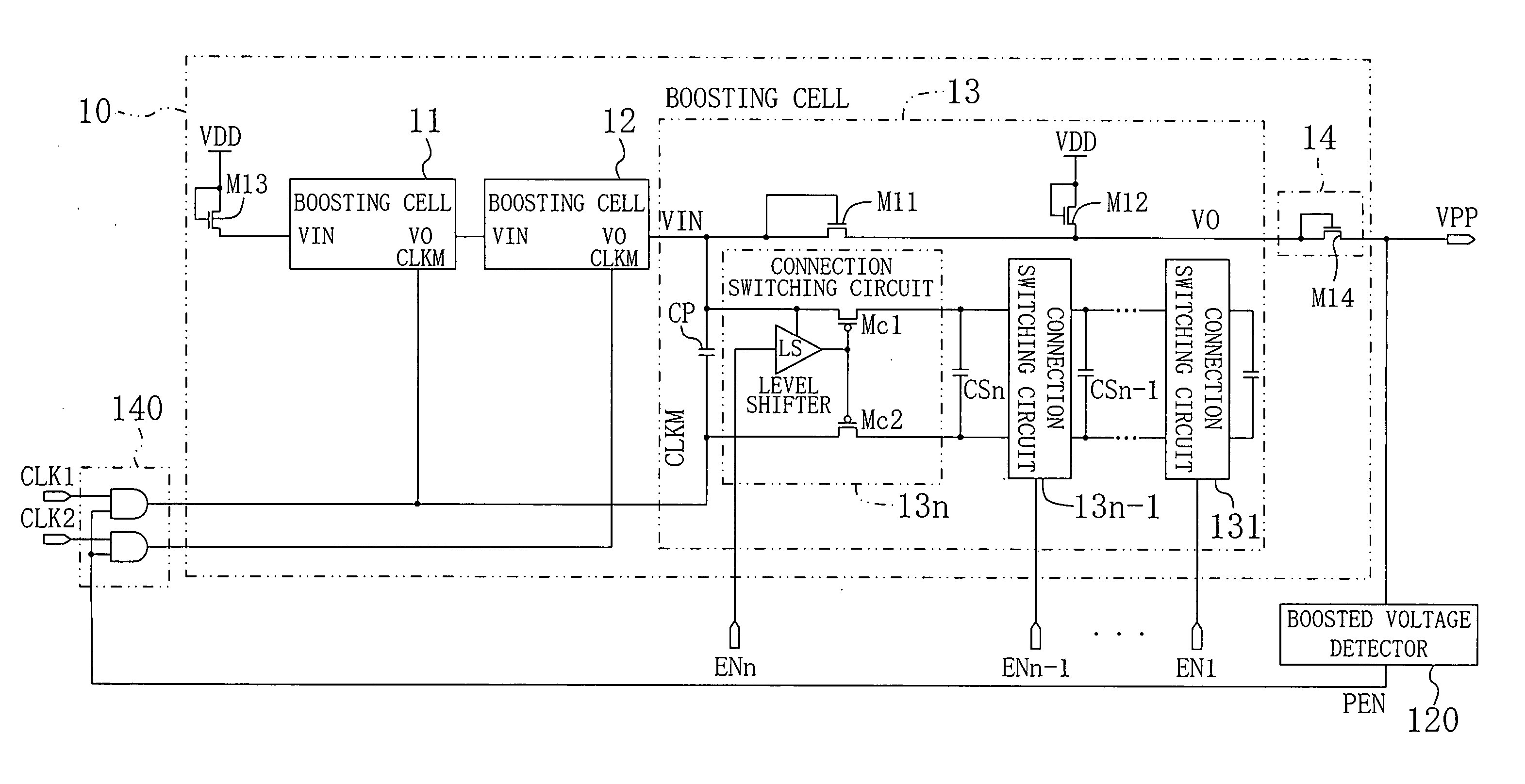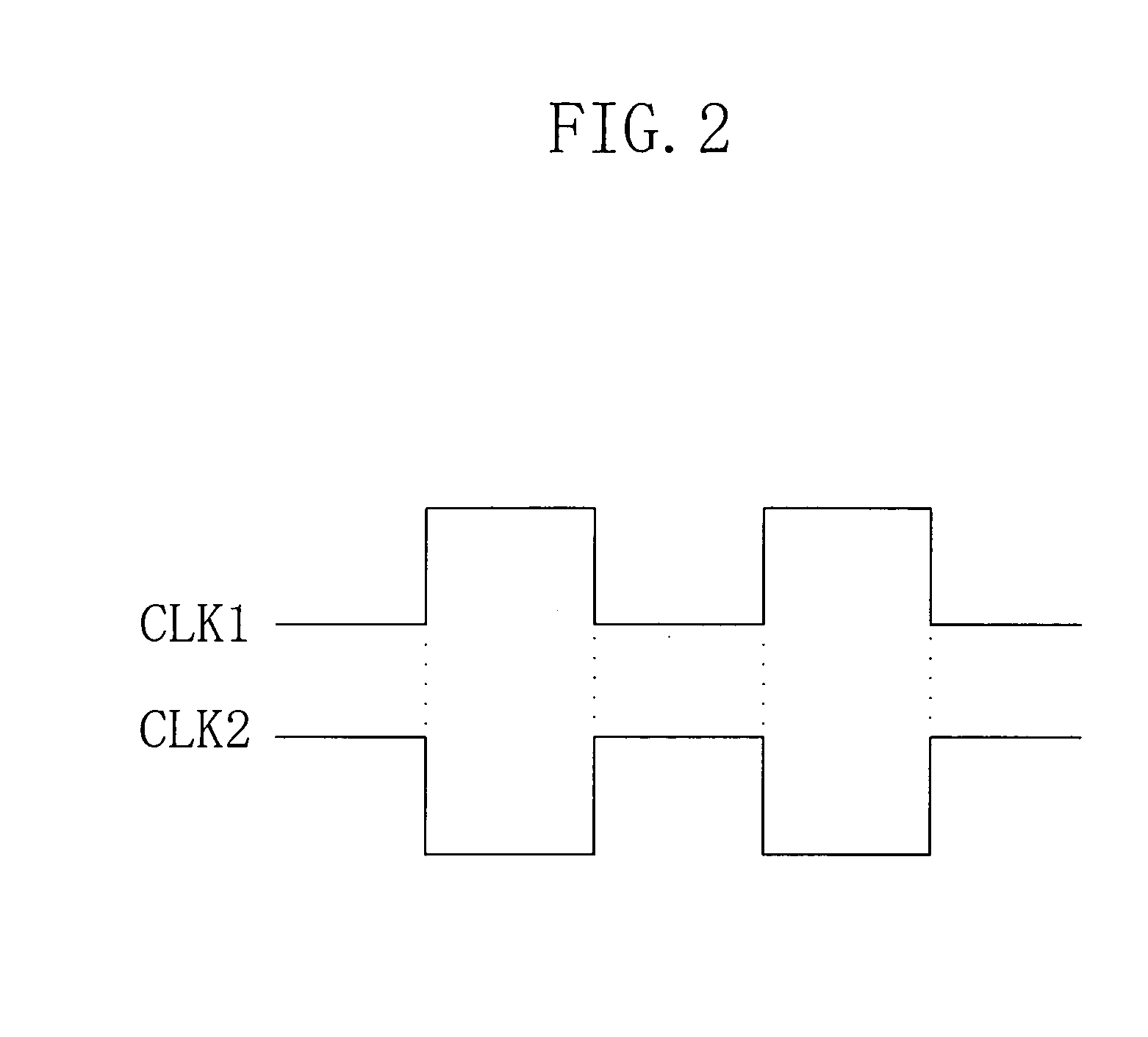Booster circuit
a technology of boosting circuit and boosting voltage, which is applied in the direction of electric variable regulation, process and machine control, instruments, etc., can solve the problems of large circuit scale, difficult control of boosted output potential, delay in determining output potential, etc., and achieve the reduction of boosting ability, preventing overshoot of boosted voltage, and reducing power supply current in the operation of boosting section.
- Summary
- Abstract
- Description
- Claims
- Application Information
AI Technical Summary
Benefits of technology
Problems solved by technology
Method used
Image
Examples
embodiment 1
[0049] (EMBODIMENT 1)
[0050] A first embodiment of the present invention will be described with reference to the drawings.
[0051]FIG. 1 shows a booster circuit according to the first embodiment of the present invention.
[0052] As shown in FIG. 1, the booster circuit of the first embodiment includes: a boosting section 10 including boosting cells 11, 12 and 13 in three stages connected in series and a power outputting unit 14 which is provided at the output side of the boosting cell 13 at the final stage and is constituted by an n-transistor M14 having a diode connection; a boosted voltage detector 120 for detecting an output voltage (boosted voltage) VPP output from the boosting section 10 and, when the detected output voltage VPP is lower than or equal to a given voltage value, outputting a clock control signal (detection signal) PEN; and a boosting clock control circuit 140 for selectively outputting a clock signal CLK1 or CLK2 received from the outside to each of the boosting cell...
embodiment 2
[0068] (EMBODIMENT 2)
[0069] Hereinafter, a second embodiment of the present invention will be described with reference to the drawings.
[0070]FIG. 4 shows a booster circuit according to the second embodiment of the present invention. In FIG. 4, each member already shown in FIG. 1 will be identified by the same reference numeral, and the description thereof will be omitted.
[0071] As shown in FIG. 4, the booster circuit of the second embodiment includes: a boosting section 10A including boosting cells 21, 22 and 23 in three stages connected in series and a power outputting unit 24 provided at the output side of the boosting cell 23 at the final stage and constituted by an n-transistor having a diode connection; a boosted voltage detector 120 for detecting an output voltage (boosted voltage) VPP output from the boosting section 10A and, when the detected output voltage VPP is lower than or equal to a given voltage value, outputting a clock control signal PEN; a boosting clock control ...
embodiment 3
[0082] (EMBODIMENT 3)
[0083] Hereinafter, a third embodiment of the present invention will be described with reference to the drawings.
[0084]FIG. 6 shows a booster circuit according to the third embodiment of the present invention. In FIG. 6, each member already shown in FIG. 1 will be identified by the same reference numeral, and the description thereof will be omitted.
[0085] As shown in FIG. 6, the booster circuit of the third embodiment includes: a boosting section 10B including boosting cells 31, 32 and 33 in three stages connected in series and a power outputting unit 34 which is provided at the output side of the boosting cell 33 at the final stage and is constituted by an n-transistor having a diode connection; a boosted voltage detector 120 for detecting an output voltage (boosted voltage) VPP output from the boosting section 10B and, when the detected output voltage VPP is lower than or equal to a given voltage value, outputting a clock control signal PEN; and a boosting c...
PUM
 Login to View More
Login to View More Abstract
Description
Claims
Application Information
 Login to View More
Login to View More - R&D
- Intellectual Property
- Life Sciences
- Materials
- Tech Scout
- Unparalleled Data Quality
- Higher Quality Content
- 60% Fewer Hallucinations
Browse by: Latest US Patents, China's latest patents, Technical Efficacy Thesaurus, Application Domain, Technology Topic, Popular Technical Reports.
© 2025 PatSnap. All rights reserved.Legal|Privacy policy|Modern Slavery Act Transparency Statement|Sitemap|About US| Contact US: help@patsnap.com



